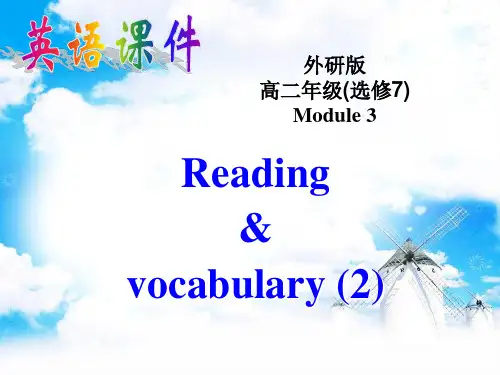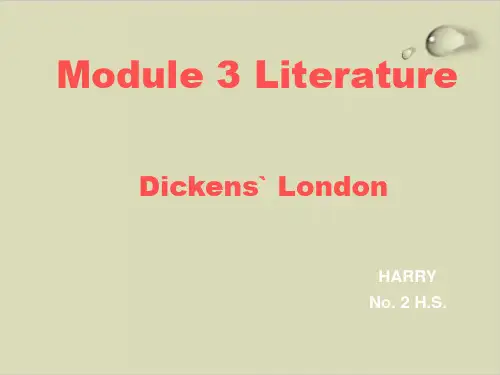外研社选修七module 3 reading practice Dickens' London
- 格式:ppt
- 大小:546.00 KB
- 文档页数:19
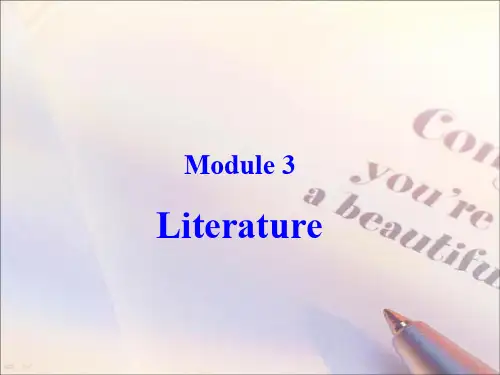
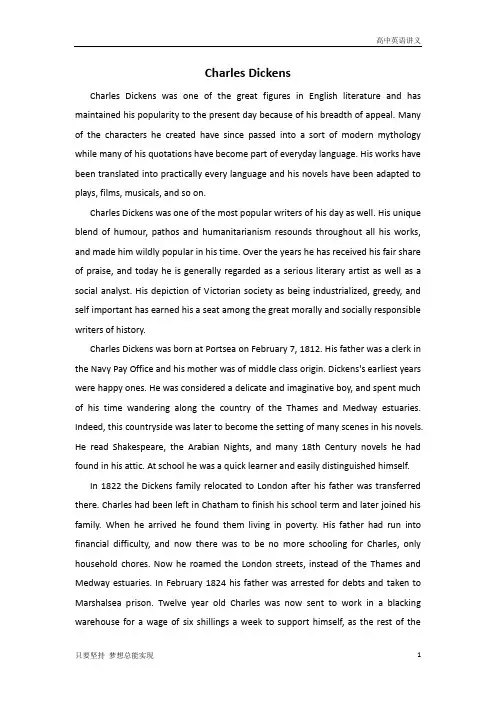
Charles DickensCharles Dickens was one of the great figures in English literature and has maintained his popularity to the present day because of his breadth of appeal. Many of the characters he created have since passed into a sort of modern mythology while many of his quotations have become part of everyday language. His works have been translated into practically every language and his novels have been adapted to plays, films, musicals, and so on.Charles Dickens was one of the most popular writers of his day as well. His unique blend of humour, pathos and humanitarianism resounds throughout all his works, and made him wildly popular in his time. Over the years he has received his fair share of praise, and today he is generally regarded as a serious literary artist as well as a social analyst. His depiction of Victorian society as being industrialized, greedy, and self important has earned his a seat among the great morally and socially responsible writers of history.Charles Dickens was born at Portsea on February 7, 1812. His father was a clerk in the Navy Pay Office and his mother was of middle class origin. Dickens's earliest years were happy ones. He was considered a delicate and imaginative boy, and spent much of his time wandering along the country of the Thames and Medway estuaries. Indeed, this countryside was later to become the setting of many scenes in his novels. He read Shakespeare, the Arabian Nights, and many 18th Century novels he had found in his attic. At school he was a quick learner and easily distinguished himself.In 1822 the Dickens family relocated to London after his father was transferred there. Charles had been left in Chatham to finish his school term and later joined his family. When he arrived he found them living in poverty. His father had run into financial difficulty, and now there was to be no more schooling for Charles, only household chores. Now he roamed the London streets, instead of the Thames and Medway estuaries. In February 1824 his father was arrested for debts and taken to Marshalsea prison. Twelve year old Charles was now sent to work in a blacking warehouse for a wage of six shillings a week to support himself, as the rest of theDickens family had relocated in the Marshalsea. His father was released in May 1824, but let Charles continue working for a few weeks more.It was these months of humiliation and despair that were to have a profound impact on Charles Dickens. It was this experience that provided him with the relentless drive he was known for, and it was this experience that inspired the creation of the suffering children and victims of injustice so often found in his books.Dickens studied for a few more years at Wellington House Academy, and then at age fifteen he became an office boy at the law firm of Ellis and Blackmore. Increasingly dissatisfied with this dull work, he eventually turned to journalism. By 1832 he was general reporter for the True Sun and also parliamentary reporter for his uncle's newspaper, the Mirror of Parliament. He also began writing fictional stories for London magazines. These stories attracted attention and in February 1836 a two volume collection was published named Sketches By Boz.At the same time Dickens's first novel, Pickwick Papers (1836-1837) was being written. This coincided with his marriage to Catherine Hogarth. Catherine bore him ten children in fifteen years, but their relationship eventually deteriorated and they separated in 1858.In the meantime, Pickwick Papers brought Charles Dickens fame. In the next eight years he produced five more novels, miscellaneous stories, and several Christmas books, most notable of which was A Christmas Carol, which was published in 1843 and quickly became one of the world's classics. His many books on various themes earned Dickens a reputation as a social reformer. His public, which he had once made laugh, he now made cry, especially with the death of little Nell in The Old Curiosity Shop. The character of Nell was based on his sister-in-law, Mary Hogarth, who at age seventeen took ill and died in Dickens's arms. This sad memory was to haunt him till the end of his days.By 1849 Dickens had slowed in writing, but was reaching the peak of his creative powers. Between 1849-1850 he wrote his most autobiographical novel, David Copperfield. This was followed by Bleak House (1852-1853), Hard Times (1854), and Little Dorrit (1855-1857). In Little Dorrit there is a fusion of the autobiographical andsocial criticism, as the Marshalsea debtors' prison is displayed as a symbol of England's condition. This was followed by A Tale Of Two Cities (1859) and Great Expectations (1860-1861).These later novels showed a Dickens who was more somber than before. This was partly a result of social disillusionment and partly of personal and domestic circumstances. Despite his literary successes, Dickens was not a happy man. His marriage was falling apart and in the spring of 1859 he and his wife separated. The immediate reason for the breakup was Dickens's growing attraction to the young actress Ellen Lawless Ternan.Charles Dickens spent the last decade of his life in increased personal unhappiness and failing health. He gained no real happiness from his relationship with Ellen Ternan. Moreover, his sons, given all the advantages he lacked, were not turning out as well as he had hoped. One or two of them apparently had inherited their grandfather's attitude towards money and it seemed they were destined for useless lives much in the manner of the early Pip in Great Expectations.From 1858 onward, Dickens spent much of his energy giving a series of public readings from his own works. They were extremely successful, and in 1867, despite poor health, he visited the United States where his performances were a great success as well. He left the United States in April 1868 in irreparably poor health. He continued to push himself, and was halfway through his last novel, The Mystery of Edwin Drood, when he had a stroke and died, at Glad's Hill, on June 9, 1870. He was buried five days later in Westminster Abbey.。
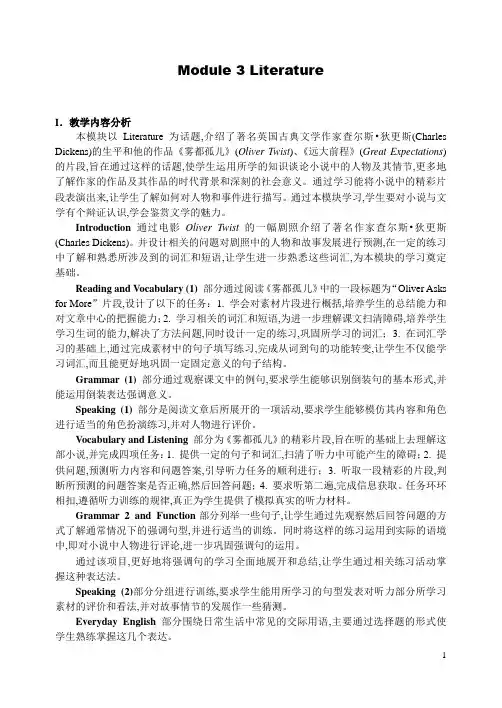
Module 3 LiteratureI.教学内容分析本模块以Literature为话题,介绍了著名英国古典文学作家查尔斯•狄更斯(Charles Dickens)的生平和他的作品《雾都孤儿》(Oliver Twist)、《远大前程》(Great Expectations)的片段,旨在通过这样的话题,使学生运用所学的知识谈论小说中的人物及其情节,更多地了解作家的作品及其作品的时代背景和深刻的社会意义。
通过学习能将小说中的精彩片段表演出来,让学生了解如何对人物和事件进行描写。
通过本模块学习,学生要对小说与文学有个辩证认识,学会鉴赏文学的魅力。
Introduction 通过电影Oliver Twist的一幅剧照介绍了著名作家查尔斯•狄更斯(Charles Dickens)。
并设计相关的问题对剧照中的人物和故事发展进行预测,在一定的练习中了解和熟悉所涉及到的词汇和短语,让学生进一步熟悉这些词汇,为本模块的学习奠定基础。
Reading and Vocabulary (1) 部分通过阅读《雾都孤儿》中的一段标题为“Oliver Asks for More”片段,设计了以下的任务:1. 学会对素材片段进行概括,培养学生的总结能力和对文章中心的把握能力;2. 学习相关的词汇和短语,为进一步理解课文扫清障碍,培养学生学习生词的能力,解决了方法问题,同时设计一定的练习,巩固所学习的词汇;3. 在词汇学习的基础上,通过完成素材中的句子填写练习,完成从词到句的功能转变,让学生不仅能学习词汇,而且能更好地巩固一定固定意义的句子结构。
Grammar (1) 部分通过观察课文中的例句,要求学生能够识别倒装句的基本形式,并能运用倒装表达强调意义。
Speaking (1) 部分是阅读文章后所展开的一项活动,要求学生能够模仿其内容和角色进行适当的角色扮演练习,并对人物进行评价。
Vocabulary and Listening部分为《雾都孤儿》的精彩片段,旨在听的基础上去理解这部小说,并完成四项任务:1. 提供一定的句子和词汇,扫清了听力中可能产生的障碍;2. 提供问题,预测听力内容和问题答案,引导听力任务的顺利进行;3. 听取一段精彩的片段,判断所预测的问题答案是否正确,然后回答问题;4. 要求听第二遍,完成信息获取。
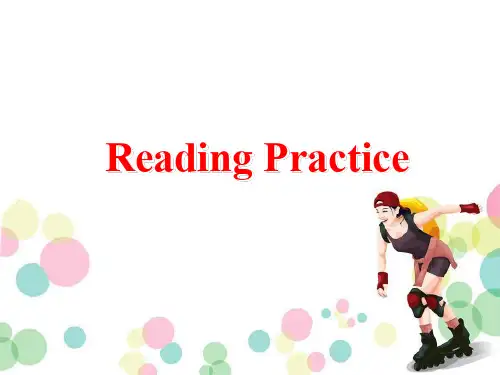

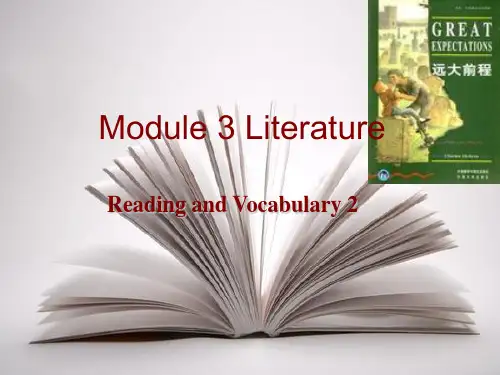
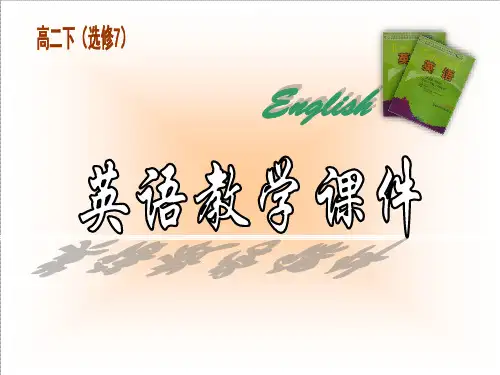
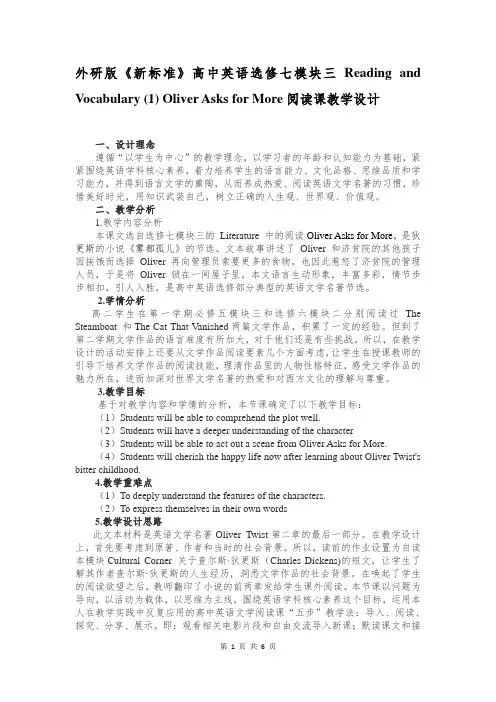
外研版《新标准》高中英语选修七模块三Reading and Vocabulary (1) Oliver Asks for More阅读课教学设计一、设计理念遵循“以学生为中心”的教学理念,以学习者的年龄和认知能力为基础,紧紧围绕英语学科核心素养,着力培养学生的语言能力、文化品格、思维品质和学习能力,并得到语言文学的熏陶,从而养成热爱、阅读英语文学名著的习惯,珍惜美好时光,用知识武装自己,树立正确的人生观、世界观、价值观。
二、教学分析1.教学内容分析本课文选自选修七模块三的Literature 中的阅读Oliver Asks for More,是狄更斯的小说《雾都孤儿》的节选。
文本故事讲述了Oliver 和济贫院的其他孩子因挨饿而选择Oliver 再向管理员索要更多的食物。
也因此惹怒了济贫院的管理人员,于是将Oliver 锁在一间屋子里。
本文语言生动形象,丰富多彩,情节步步相扣,引人入胜,是高中英语选修部分典型的英语文学名著节选。
2.学情分析高二学生在第一学期必修五模块三和选修六模块二分别阅读过The Steamboat 和The Cat That Vanished两篇文学作品,积累了一定的经验。
但到了第二学期文学作品的语言难度有所加大,对于他们还是有些挑战。
所以,在教学设计的活动安排上还要从文学作品阅读要素几个方面考虑,让学生在授课教师的引导下培养文学作品的阅读技能,理清作品里的人物性格特征,感受文学作品的魅力所在,进而加深对世界文学名著的热爱和对西方文化的理解与尊重。
3.教学目标基于对教学内容和学情的分析,本节课确定了以下教学目标:(1)Students will be able to comprehend the plot well.(2)Students will have a deeper understanding of the character(3)Students will be able to act out a scene from Oliver Asks for More.(4)Students will cherish the happy life now after learning about Oliver Twist's bitter childhood.4.教学重难点(1)To deeply understand the features of the characters.(2)To express themselves in their own words5.教学设计思路此文本材料是英语文学名著Oliver Twist第二章的最后一部分。

